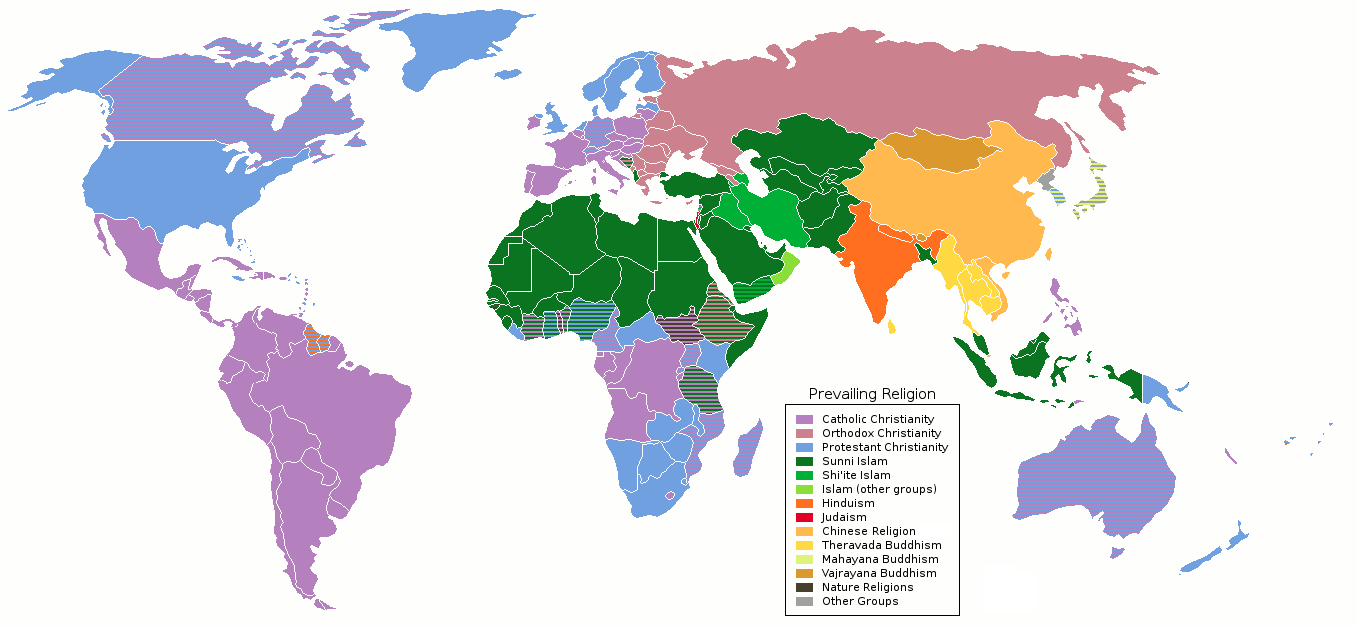Chapter 8: The Geography of Religion
8.2 Religion in the World
“I love you when you bow in your mosque, kneel in your temple, pray in your church. For you and I are sons of one religion, and it is the Spirit.”
—Khalil Gibran
Religion is defined by Webster[1] as a personal set or institutionalized system of religious attitudes, beliefs, and practices .
Wikipedia elaborates on this by stating the following[2]: Religion is a range of social-cultural systems, including designated behaviors and practices, morals, beliefs, worldviews, texts, sanctified places, prophecies, ethics, or organizations, that generally relate humanity to supernatural, transcendental, and spiritual elements
This chapter is an exploration of the geography of religion. Like language and ethnicity, religion is a cultural characteristic that can be closely bound to individual identity. Religion can provide a sense of community, social cohesion, moral standards, and identifiable architecture. It can also be a source of oppression, social discord, and political instability.
The following pie chart (Figure 8.1) gives us an idea of the relative size in terms of adherents of the world’s major religions. But please bear in mind that these numbers are estimates; there is no world governing body collecting detailed statistics on religion. As one can see, Christians and Muslims make up over half of the world’s population. The next category, the unaffiliated, is a large but diffuse body containing people who do not identify with any religion. Hindus, who cluster in the Indian subcontinent, are the next largest group. Buddhists make up approximately 7% and are closely followed by the Folk religions. The category of Folk religion is similar to that of Unaffiliated—it is a large group of religions that are bound into one category solely for logical consistency. Folk religions may consist of ancestor worship in China, animism in central Africa, or any other number of indigenous, local religions. The Other category contains newer religions that are just gaining their footholds and other religions that may be fading in the contemporary milieu. Judaism is included in the chart, although it has comparatively few adherents (less than 0.5%). It is included for two reasons. First, it provided the cultural spoor for both Christianity and Islam, and second, it is the predominant religion of the modern state of Israel.

Source: “Adherents of worlds major religions (2015)” by Serv181920 via Wikimedia Commons is licensed under CC BY-SA 4.0.
Notice that the world map below does not differentiate between different branches of any religion; so all we are seeing are the religions proper, i.e. Christianity, Islam and so forth. The map portrays religions across country borders quite correctly.

Source: “Religion distribution” by TheGreenEditor via Wikimedia Commons is in the public domain.
If one wanted to have a more nuanced view of the most dominant branches of the various religions, the map below would do a better job. Take your time to study it carefully, there is a lot of information included that was omitted in the world map above. However, both maps do a decent job at presenting religious data. Shintoism is shown in the map above but appears unmentioned in the map below. While the legend lists Nature Religions I do not see any in Africa nor South America.

Source: “Prevailing world religions map” by LilTeK21 at English Wikipedia (original author) via Wikimedia Commons is licensed under CC BY-SA 3.0.
State religions are religions that are recognized as the official religion of a country. Analysis by the Pew Research Center found that more than one in five countries (22%) have an official state religion that is specified in the law of the country. It also found that countries with official state religions are most likely to be found in the Middle East and North Africa region. In some places with a state religion, such as Denmark (Evangelical Lutheran Church) or the United Kingdom (Church of England), the official status of one religion has little effect either on the practice of other religions or on the society at large. In places like Saudi Arabia or Pakistan, however, the official religion (Islam) is closely connected to the power of the state, most obviously in the form of blasphemy laws which allow for state penalties (including death) for violations of religious statutes. It is important to note that just because a country (e.g. United Kingdom) has an official state religion, it does not necessarily make it a theocracy.
In some parts of the world, some forms of religious expression are discouraged or banned outright. For example, in North Korea, the state ideology is known as Juche, which is not a traditional religion with supernatural elements. It is primarily a political ideology rather than a religion. It was developed by Kim Il-sung in the 1950s as a means of promoting self-reliance and independence for North Korea. While it started as a political doctrine, over time it has incorporated elements that give it a quasi-religious character, such as the reverence and almost deification of North Korea’s leaders, particularly Kim Il-sung, Kim Jong-il, and Kim Jong-un. In other places, religion has reached the status of being nominal (in name only) in which people identify with a religion, but the practices of that religion have little impact on their daily lives.
The current religious map of the world is best thought of as a snapshot. The religious landscape has been continuously changing throughout human history and will continue to change in the future. New religions are founded, and old ones die out. New religions are often made using pieces of older religions; Christianity and Islam deriving in part from Judaism and Buddhism deriving from Hinduism are not aberrations but instead are examples of a common occurrence. Within the relatively recent past, it has been possible to watch the creation and diffusion of several new religions just within the United States. Mormonism, the Jehovah’s Witnesses, and Seventh-Day Adventism are all religions that were founded in the U.S. in the relatively recent past.

